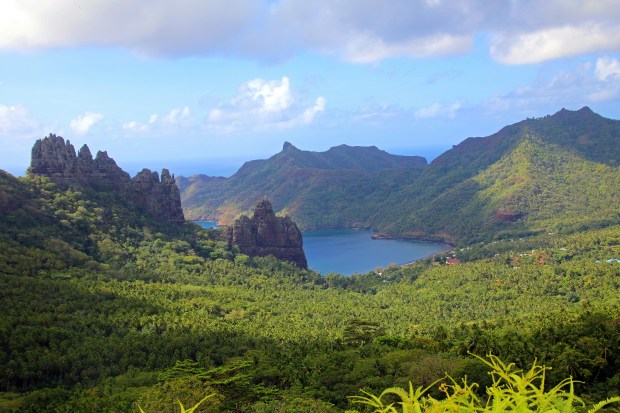[ad_1]
Wearing choker necklaces made of boar tusks, traditionally tattooed Marquesan men fiercely grunt performing the “Pig Dance” alongside a hallowed banyan tree where cannibals buried skulls of ritualistically eaten victims. At another sacred archeological site, I fixate on an ancient 8-foot-tall red rock tiki, supposedly a once-mighty warrior chief, now lingering among jungly coconut palms. Nearby, stone severed heads represent sacrificed humans.

You bet I feel the “mana” spiritual power. Partly because, as I dive into a captivating culture, my Aranui 5 passenger-freighter unloads crates of frozen chicken, powdered milk, house windows, concrete and other necessities to these far-flung Marquesas Islands at an edge of the world in French Polynesia. To get here, I traveled 1,000 nautical miles from Tahiti aboard the Aranui, a lifeline that twice-monthly brings supplies to the Marquesas, which have no other way to obtain them. In fact, a major highlight of the 11-night sailing is watching the Aranui’s cargo — everything from live horses to a Toyota truck to russet potatoes — delivered to grateful residents of all six inhabited islands in the Marquesas’ 12-island volcanic chain.

Dramatically gorgeous with mist-swathed jagged peaks, deep emerald valleys, tikis galore and scant visitors, the Marquesas are unlike the popular touristed areas of French Polynesia such as Bora Bora. Marquesans have their own language, their own style of Polynesian tattoos, their own ceremonial dances, even their own time zone (idyllically named Marquesas Islands Time) and are known for exceptional artwork, including intricate wood and bone carvings and black-ink “tapa” sketches on tree bark. We experience it all. Plus I pet a rat-detecting dog who is rescuing endangered Marquesan birds, hike to the grave of syphilis-plagued French painter Paul Gauguin, and see where “Moby Dick” author Herman Melville jumped ship.

For Aranui passengers, there’s a personal do-good aspect to voyages. Your cruise cost — cabins range from dormitory-style rooms to luxury suites with private balconies — subsidizes the transport of cargo to the Marquesas from the Aranui’s home port in Papeete, Tahiti (rates start at $3,572 per person). The family-owned Aranui also brings educational supplies, including books and computers, to island schools for free. And the crew is largely Polynesian, many from the Marquesas. (It’s also easy to reach your starting point; I took an Air Tahiti Nui direct 8-hour flight from LAX to Papeete.) During my recent July cruise, the ship was half-full with 127 guests of 14 nationalities, only a handful from America and most from France.

We’re greeted by a bare-chested native blowing a conch shell at our first Marquesas island, Nuku Hiva, the largest and most populated with around 3,000 residents. (About 9,000 people total live in the Marquesas, which has a combined 405 square miles.) Just like at other islands, friendly locals arrive in their own dusty 4X4 Toyota pickups to ferry us around. I jounce on a bench in an open truck bed as we climb rugged wildly green mountains, past cascading waterfalls, giant hibiscus, grazing horses and a pig crossing the road.

Our destination is Tohua Kamuihei, a mystical archeological site that housed long-gone temples and platforms for religious ceremonies. This is when I watch costumed war-like dancers do intimidating violent motions while gruffly shouting “Ho! Ho! Hey!” My guide Frank Macken acknowledges, “It looks like they want to kill you.” But, he notes, Marquesans were constantly at war with neighboring tribes and acted “extremely belligerent” to scare off enemies. The dancers perform in front of a centuries-old revered banyan tree, where captured combatants were kept in a prison pit before their necks were smashed without spilling blood because red is sacred. “They were hung in the banyan tree until they rotted away and their mana passed into the tree,” Macken says. Other people were sacrificed in rituals asking for help from the gods; their hearts, brains and lungs were devoured (again, for the mana) and their skulls buried at the banyan tree.
Before writing books, Melville deserted his whaling ship in 1842 in Nuku Hiva and worried that the clan that took him in were cannibals. And perhaps fittingly, the cutthroat CBS reality show “Survivor” filmed its 2002 season in Nuku Hiva.

It seems a lot of Marquesans I meet on this trip have elaborate tattoos — such as squiggles, geometric shapes, decorative borders, Marquesan crosses, manta rays and tikis — all intimately significant to them and a spiritual core of the culture for 2,000 years. There is even a resident Marquesan tattoo artist onboard the Aranui, which may be the only cruise ship in the world indelibly etching passengers with Polynesian mementos.
Historically the body art has represented the wearer’s status, rank, achievements and protection. Chiefs could have distinctive facial spirals; young women had their hands tattooed first to purify them for preparing food. Catholic missionaries on the islands banned the practice in the early 19th century before French officials outlawed it in 1884. The Marquesans, however, documented the patterns and eventually revived the rich tradition.

“This is the story of my life and my family,” explains Cyril Tehautetua, a 50-year-old villager tattooed neck to ankles. “It says when I was happy or not happy, every story when I was young, when I met my wife, when I had my two sons.”
He’s one of the bone carvers on Tahuata selling detailed tiki-motif jewelry and ornaments sculpted from cow and swordfish skeletons. After the Aranui anchors off this 23-square-mile island, passengers ride barges to shore, as we have at other stops. Meanwhile, the Aranui crew swings the bow’s two yellow cranes to unload stacks of lumber, drums of gasoline and boxes of food into wood flat-bottomed boats that will repeatedly cross the bay with supplies. It’s quite an operation.

Some of Tahuata’s 670 inhabitants wait with trucks for the goods, which include Tahitian Hinano beer, white rice, peanut butter, onions and carrots. To help the Marquesas economy, the Aranui also takes back products to Tahiti, normally sacks of copra coconut meat, limes, lemons and grapefruit. In Tahuata, a bloodied butchered goat in a fly-covered bag is being sent by a local to a relative in Tahiti.
The Aranui has been a passenger-freight vessel for 38 years, except during COVID lockdowns when only cargo was aboard.

“We had to keep going because we bring everything for everyday life on the islands,” the Aranui’s personable captain, Arnaud Pichard, tells me in the open bridge. He also reveals that this evening we’ll have to double back to Nuku Hiva, where our ship three days ago dropped off a helicopter repaired in Tahiti and used for medical evacuations. Nuku Hiva dock workers had mistakenly refused to accept a carton that, it turned out, was a helicopter part. By sailing all night, we keep on schedule.

Depending on the island, we explore small museums, hike in paradise, lunch at colorful restaurants, buy handicrafts, peek into churches and attend cultural gatherings. On Ua Huka, pareo-clad welcomers drape us with seed necklaces before Aranui’s cargo is examined by a frisky terrier in a “Best Buddy” neon green halter. The parrot-saving dog searches for black rats that prey on Marquesan ultramarine lorikeets, wiped out from the islands except this one.

On Fatu Hiva, a villager pounds breadfruit tree bark into tapa cloth and weaves customary floral headdresses from pandanus leaves and plumeria. I kick around a fraying soccer ball with a 9-year-old Marquesan boy who keeps giggling, “More!”
In a Catholic cemetery in Hiva Oa, we peer at the grave of Gauguin, the controversial post-Impressionist artist who settled here to paint Polynesian scenes. But the indisputable lure of this island is Te I’ipona, an archeological site with an eerie collection of ancient tikis.

Tikis are half-human, half-god icons, who offer protection and usually represent ancestors. Their eyes and heads are big because of their knowledge. Macken, my guide, points to an 8-foot-tall eroding figure, the largest tiki in French Polynesia. “He’s the most famous chief. He’s made of red volcanic stone because red is a sacred color. His name is Takaii which means red and anger. He probably had a temper too.”

A haunting grey tiki, Taua Pepe, portrays a prone grimacing woman giving birth to a stillborn baby, according to Macken. Marquesan expectant mothers visit the statue because, oddly, it’s good luck. They also tattoo the Marquesan cross near their ear to prevent evil spirits from entering their pregnant bodies.
As for the decapitated tiki heads, Macken explains they honor sacrificed victims “so their mana doesn’t turn against you.”

Back on the ship, I wrap myself in a festive pareo sarong, tuck a gardenia in my hair and clumsily try to learn the legendary hip-rolling Marquesan “Bird Dance” on the pool deck. But wait, is that an ocean swell under my feet? Or a supernatural pull? Ask my newly bought wood tiki, sternly standing guard in my cabin.
[ad_2]
Source link



















